Railway Express Agency
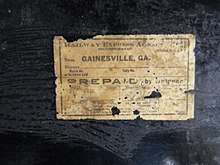

The Railway Express Agency (REA), founded as the American Railway Express Agency and later renamed the American Railway Express Inc., was a national package delivery service that operated in the United States from 1918 to 1975. REA arranged transport and delivery via existing railroad infrastructure, much as today's UPS or DHL companies use roads and air transport. It was created through the forced consolidation of existing services into a federal near-monopoly to ensure the rapid and safe movement of parcels, money, and goods during World War I.
REA ceased operations in 1975, when its business model ceased to be viable.
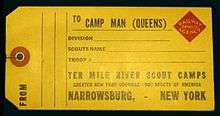
Early history
Express delivery in the early 19th century was almost all by horse, whether by stagecoach or riders. The first parcel express agency in the United States is generally considered to have been started by William Frederick Harnden (1812-1845), who in 1839 began regular trips between New York City and Boston, Massachusetts, as a courier transporting small parcels, currency and other valuables. Another one, Wells Fargo & Co., was founded in 1853 by William G. Fargo, a New York Central freight clerk at Auburn, New York, and Henry Wells, a leather worker at Batavia, New York. Other parcel express pioneers include Henry B. Plant, who formed Southern Express Company; Alvin Adams, who founded Adams Express Company; and John Warren Butterfield.
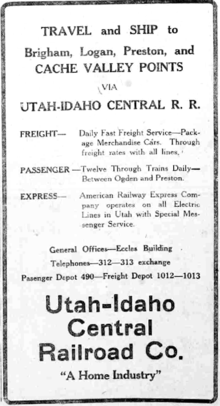
The express business flourished in the latter half of the 19th century, and by 1900 there were four principal parcel express companies, all of which included the rapidly advancing railways as one of their means of transport: Adams Express Company, Southern Express Company, American Express Company, and Wells Fargo. Another competitor arrived in 1913: the U.S. Post Office with its Parcel Post service. Still, private railway express business increased steadily through the end of World War I.

During the winter of 1917, the United States suffered a severe coal shortage. On December 26, President Woodrow Wilson commandeered the railroads on behalf of the United States government to move federal troops, their supplies, and coal. Treasury Secretary William Gibbs McAdoo was assigned to consolidate the railway lines for the war effort. All contracts between express companies and railroads were nullified and McAdoo proposed that all existing express companies be consolidated into a single company to serve the country's needs. The result was that a new company called the American Railway Express Agency formed in July 1918. The new entity took custody of all the pooled equipment and property of existing express companies (the largest share of which, 40%, came from American Express, who had owned the rights to the express business over 71,280 miles (114,710 km) of railroad lines, and had 10,000 offices, with over 30,000 employees). During World War I, the United States Railroad Administration (USRA) took over the nation's railroads. Under the USRA, the four major and three minor express companies were consolidated as American Railway Express, Inc., except for the portion of Southern Express that operated over the Southern Railway and the Mobile & Ohio.[1]
In March 1929, the assets and operations of American Railway Express Inc. were transferred to Railway Express Agency (REA). REA was owned by 86 railroads in proportion to the express traffic on their lines; no one railroad or group of railroads controlled the agency. In response to customer demand, REA added a Chicago, Illinois-based refrigerator car line. In 1927, REA began an Air Express Division.[2] In 1938, the remainder of Southern Express also joined the consolidated REA.
Post-World War II
Due to rate increases, express operations remained profitable into the 1950s. REA concentrated on express refrigerator service after 1940, and continued to expand its fleet of express reefers until the mid- to late-1950s, business declined dramatically thanks to competition from refrigerated motor trucks. By this time, overall rail express volume had also decreased substantially.
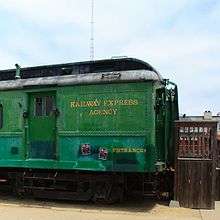
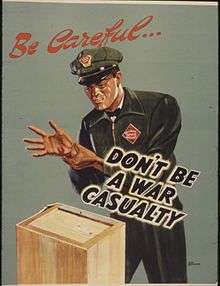
In 1959, REA negotiated a new contract allowing it to use any mode of transportation. It also acquired rights to allow continued service by truck freight after passenger trains were discontinued. REA also attempted to enter the piggyback and container operations business, without success. Another blow came when the Civil Aeronautics Board terminated REA's exclusive agreement with the airlines for air express.
REA Express and decline
In the early 1960s Railway Express Agency was renamed REA Express.[3] By 1965 many of REA's refrigerator cars, now stripped of their refrigeration equipment, were in lease service as bulk mail carriers. Many ended their days relegated to work train service.
In 1969, after several years of losses, REA was sold to five of its corporate officers. By then its entire business constituted less than ten percent of all intercity parcel traffic, while only ten percent of its business moved by rail.
REA Express became embroiled in extensive litigation with the railroads and the United Parcel Service as well as with the Brotherhood of Railway Workers' Union. In November 1975, REA Express terminated operations and filed for bankruptcy. During the strike in October 1974, the first Altair 8800 microcomputer was lost, as it had been shipped from Albuquerque to New York heading for Popular Electronics magazine a few weeks earlier via REA and never arrived.[4]
References
- ↑ Technology, Invention, and Innovation collections Archived 2010-03-11 at the Wayback Machine.
- ↑ p.589 The World Almanac and Book of Facts Abe Books
- ↑ Winter 1962-1963 Central of Georgia Railway timetable states "Railway Express Agency has a new name R E A Express."
- ↑ Les Solomon, "Solomon's Memory", Digital Deli, 1984
- The Historical Guide to North American Railroads, George Drury, ed. Kalmbach Publishing Co. 1985 edition
- The Adams Express Company: 150 Years (corporate history largely devoted to its rail-express past)
External links
- NRHS Archives: Railway Express Agency
- North East Rails: Railway Express Agency
- Drury, George H. (2006-06-05). "Railway Express Agency: Yesterday's Federal Express". Trains Magazine. Kalmbach Publishing.